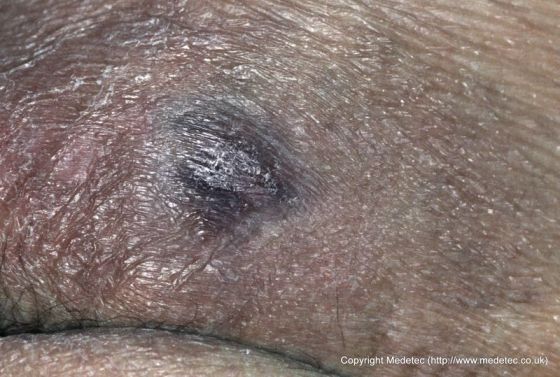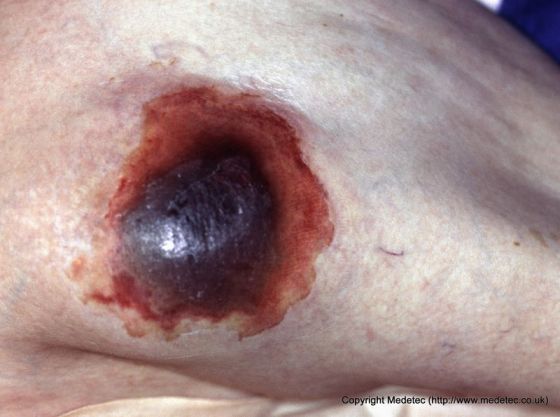Pressure Injuries, Deep Tissue Pressure Injury (DTPI)
Pressure injuries are localized areas of tissue necrosis that typically develop when soft tissue is compressed between a bony prominence and an external surface for a long period of time. Deep tissue pressure injuries (DTPI) are persistent non-blanchable deep red, purple or maroon areas of intact skin, non-intact skin or blood-filled blisters caused by damage to the underlying soft tissues. It is common for a thin blister to form over the surface of the dark wound bed, and the wound may further evolve to become covered by thin eschar. These represent a serious form of pressure injury in that they form in the underlying tissues and are often not visible until they have advanced to the point where treatment is significantly more problematic. Deep tissue injuries are also known to deteriorate quickly even under optimal care.
Symptoms of Deep Tissue Pressure Injuries
In addition to the localized discoloration (which may be more difficult to detect in patients with dark skin tones), deep tissue injuries can be preceded by tissue that is painful, differs in consistency (firm or boggy), or differs in temperature (warmer or cooler) as compared to adjacent tissue.


Etiology
The following are considered to be potential causes of deep tissue pressure injuries:
- Direct pressure to the skin and soft tissue with resulting ischemia
- Muscle injury associated insufficient nutrient delivery through the arterioles that feed the muscles (infarction)
- Injury or damage to the fascia (the layer of fibrous tissue that surrounds muscles, bones, blood vessels and nerves)
- Shearing injury or torsion of the perforating vessels
Risk Factors
- Immobility or limited mobility
- Spinal cord injury
- Diseases that affect blood flow such as diabetes or atherosclerosis
- Fragile skin
- Urinary or fecal incontinence
- Poor nutrition or dehydration
- Decreased mental awareness
- Obesity
- Neuropathy
- Fever
- Anemia
- Infection
- Ischemia
- Hypoxemia
- Neurological disease
Complications
Infection is the most common major complication of pressure injuries. If the ulcer progresses far enough, it can lead to osteomyelitis (infection of the underlying bone) or sinus tracts, which themselves can be either superficial or connect to deeper structures.
Diagnostic Studies
- Laser doppler blood flow studies
- Ultrasound
Treatments of Deep Tissue Pressure Injuries
Treatment of deep tissue pressure injuries should include the measures used for any pressure injury, including frequent repositioning off the site of injury, good skin care, proper support surface selection, as well as correcting any systemic issues or nutritional deficiencies. Offloading and avoidance of shearing forces is crucial with these ulcers since ischemia and infarction of nutrient supply is thought to be a cause. Monitor the wound site carefully before beginning forceful removal of any tissue that appears to be necrotic. Skin beneath the covering blister should be left in place if the area is stable.
The following precautions can help minimize the risk of developing pressure ulcers injuries in at-risk patients and to minimize complications in patients already exhibiting symptoms:
- Patient should be repositioned with consideration to the individual’s level of activity, mobility and ability to independently reposition. Q2 hour turning is the standard in many facilities, but some patients may require more or less frequent repositioning, depending on the previous list.
- Keep the skin clean and dry.
- Avoid massaging bony prominences.
- Provide adequate intake of protein and calories.
- Maintain current levels of activity, mobility and range of motion.
- Use positioning devices to prevent prolonged pressure bony prominences.
- Keep the head of the bed as low as possible to reduce risk of shearing.
- Keep sheets dry and wrinkle free.
References
Fleck CA. Deep Tissue Injury: What, Why and When? Wound Care Canada. 2007;5(2):10-12,53. http://cawc.net/images/uploads/wcc/5-2-fleck.pdf. Accessed August 22, 2012.
Merck Sharp & Dohme Corp. Pressure Ulcers. The Merck Manual. http://www.merckmanuals.com/professional/dermatologic_disorders/pressure.... Updated October 2008. Accessed August 22, 2012.
National Pressure Injury Advisory Panel. Prevention and Treatment of Pressure Ulcers/Injuries: Clinical Practice Guideline. The International Guideline 2019
Rosenfeld Law Offices. What is a ‘deep tissue’ injury? Bed Sore FAQs. http://www.bedsorefaq.com/what-is-a-deep-tissue-injury/. Accessed August 22, 2012.
Salcido R. Pressure Ulcers and Wound Care. Medscape Reference. http://emedicine.medscape.com/article/319284-overview#aw2aab6b2. Updated January 18, 2012. Accessed August 22, 2012.
Images copyright Medetec (www.medetec.co.uk). Used with permission.







